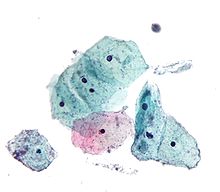Trichomoniasis
| Classification according to ICD-10 | |
|---|---|
| A59.0 | Urogenital trichomoniasis |
| A59.8 | Other locations of trichomoniasis |
| A59.9 | Trichomoniasis, unspecified |
| A07.8 | Other specified intestinal diseases caused by protozoa |
| ICD-10 online (WHO version 2019) | |
Trichomoniasis is a sexually transmitted disease of the urogenital tract that occurs in men and women and originates from a flagellate , Trichomonas vaginalis (also called Trichomonas urogenitalis ). The vagina and the male urethra become inflamed . Sexual intercourse is the main mode of transmission of the disease. Trichomoniasis can be detected by microscopic examination of a vaginal swab and treated with the active ingredient metronidazole within 5 to 6 days . Trichomoniasis is one of the most common sexually transmitted diseases worldwide, with 170 million new infections per year.
Pathogen
Trichomoniasis is caused in humans by the flagellate Trichomonas vaginalis , which like all trichomonads cannot survive for long outside of its habitat.
Symptoms
In men
In most men the infestation is symptom-free . Above all, the trichomonads nest in the prostate , the urethra and under the penile foreskin . Occasionally there is a painful inflammation of the urethra. The seminal vesicles are rarely affected. Since men usually do not experience any symptoms, they often do not know anything about the infection and are the main carriers of the parasites .
In women

In around 80 percent of women, after a longer period without symptoms, inflammation (trichomonads colpitis) and thin, yellowish, foul-smelling vaginal discharge ( fluorine vaginalis ), in which bacteria and pus cells can be found in addition to trichomonads . This is often associated with itching in the vagina. The urethra is affected in three quarters of the patients. Infections of the uterus and the urinary bladder , however, are rare. Temporary infertility has also been observed. Trichomonads can be detected by examining a vaginal swab microscopically .
An infestation with Trichomonas vaginalis leads to an increased susceptibility to HIV infection in girls and women . The pathogen, which looks like a pear in its mobile form, attacks the epithelium of the vagina. He flattens himself and tries to cover as large an area as possible. It then forms runners which it drills into the epithelium and taps nutrients and serum from there. At the same time, it secretes harmful proteins , which firstly lead to the death of the protective vaginal flora (mainly lactic acid bacteria) and secondly to micro- necrosis in the vaginal skin, so that tiny punctiform scars develop in it. These then form the gateway for HI viruses. Since the scars in the epithelium persist for a lifetime, an increased susceptibility to infection remains after the infection with Trichomonas vaginalis has been successfully combated. Infectibility applies in both directions. Those affected not only get infected more easily with HIV. Women who are HIV positive also become more infectious to their partners as a result.
Prevention and therapy
As with all sexually transmitted diseases , condoms do not offer absolute protection, but they do offer a high level of protection. For the treatment of infections caused by protozoa are suitable nitroimidazole derivatives such as metronidazole or tinidazole . A treatment lasts five to six days. To avoid the "ping-pong effect", drug therapy for the sexual partner is necessary. The administration of these drugs is contraindicated during pregnancy, so topical therapy with clotrimazole or natamycin is recommended . Oral administration of amoxicillin is also possible.
See also
literature
- Lykke Aresin , Helga Hörz , Hannes Hüttner , Hans Szewczyk (Eds.): Lexicon of Human Sexuology. Verlag Volk und Gesundheit, Berlin 1990, ISBN 3-333-00410-0 , p. 200.
Individual evidence
- ↑ Ernst Mutschler, Monika Schäfer-Korting: Textbook of Pharmacology and Toxicology. 8th, completely revised and expanded edition. Wissenschaftliche Verlagsgesellschaft Stuttgart 2001. ISBN 3-8047-1763-2 , page 866.
